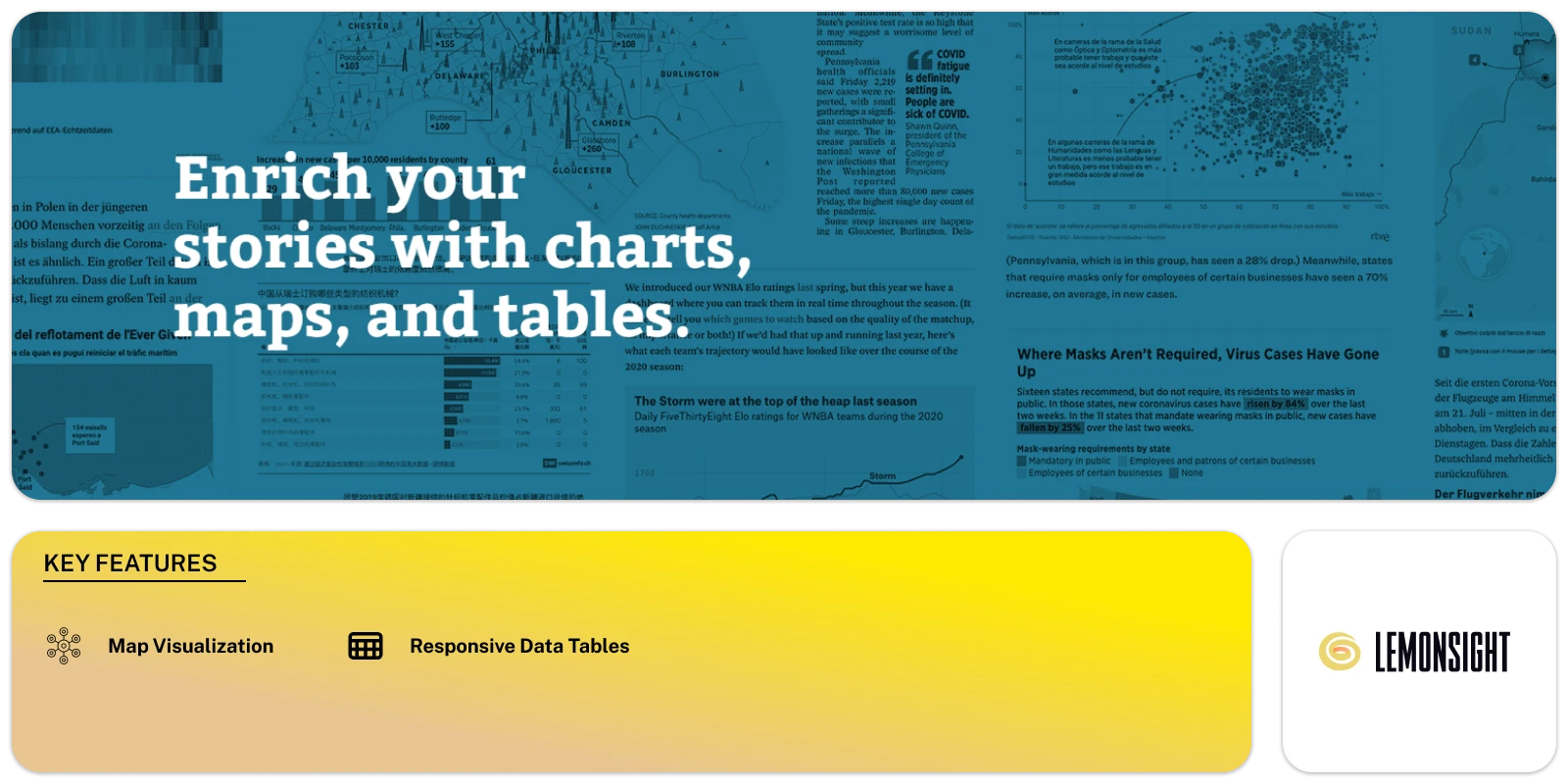

Data visualization represents data in the form of graphs and charts. The data scattered across the internet is raw, unstructured, and complex. For businesses, it’s essential to understand the raw information to draw valuable insights.
These insights help in understanding the audience and potential customers. Thus, to gain such insights from complex data, presenting them as charts and graphs is useful. Such visualization helps in making informed and better decisions.
With the advances in technology and AI, data visualization methods are easier to use. There are tons of AI tools for data visualization that will make the process easy. You can use such tools to improve your workflow and learn more. These tools help businesses, researchers, science, and many data-driven fields.
Data visualization is a technique used to represent raw data in a visually appealing and understandable form. Now, with AI, data visualization has converted to higher scales.
AI Visualization tools are software that uses AI to improve the visualization process. Using AI tools for data visualization can automate the creation and interpretation of visual representations of data.

Tableau AI is like an intelligent assistant for data experts, making their work easier. It helps them understand data and create excellent visuals faster. Einstein Copilot guides them through tasks and boosts the quality of graphs and dashboards. It keeps everything safe and fair with its Einstein Trust Layer.
Tableau AI helps everyone in a business by giving personalized insights. It’s like a customized data butler serving the correct information at the right time. Data Stories and Einstein Discovery makes it easier to explain data, explore ideas, and get intelligent suggestions.
Automate insights with Einstein Copilot and secure data with Einstein Trust Layer. Create visuals faster and get personalized, actionable insights for your team.

Microsoft’s Power BI is an efficient data visualization tool. It allows you to turn your data into interactive visuals using data analysis tools. It also has AI powers and a user-friendly report-creation tool.
You can create datasets from any source and add them to the OneLake data hub to develop a source of truth for your data. Power BI makes it easy to embed and share reports in other Microsoft services such as Teams, PowerPoint, Excel, and Power Platform. You can also find patterns in data, create reports, and get answers to your queries.
The Copilot helps create reports by describing what you want or asking questions about your data. You can add insightful text summaries to help you understand your data and tailor your narratives’ tone, scope, and style. You can also create DAX calculations faster by asking Copilot in Power BI to suggest relevant code and entire functions.
Turn your data into interactive reports. Use AI Copilot to simplify report creation and spot patterns quickly. Integrate easily with Microsoft services for smooth workflows.

Sisense’s Fusion Analytics Platform is a powerful data visualization tool. Using this tool, businesses can make smarter decisions and engage customers. It uses smart AI analytics for advanced insights from various data sources.
It offers two integration methods. One is an easy-to-use application for non-coders. The second one is a more flexible approach with SDKs and APIs for developers. You can integrate analytics into the interface and development workflow. This allows users to see enhanced analytics using charts and graphs. You can ask questions in plain language and receive AI-generated answers.
Developers can use the Sisense Compose SDK to include analytics in the code. This is a cloud-based platform that offers easy maintenance. It works well in different cloud environments and can adapt to different scales. You can create analytics without code or with low code and share insights using different visual tools.
Integrate analytics with or without code. Gain clear insights with AI-driven analytics and customize data visualizations to meet your needs.
Contact for pricing

Datawrapper is a visualization tool for creating charts, maps, and tables. It offers 19 interactive and responsive chart types, from simple bars and lines to arrow, range, and scatter plots. The tool also provides three interactive and responsive map types for creating everything from locator maps to thematic chord and symbol maps.
Its responsive data tables allow for lots of styling options. It lets you include a bar, column & line charts, heatmaps, images, a search bar, and pagination. You can copy your data from the web, Excel, or Google Sheets. You can also upload CSV/XLS files or link to a URL or Google Sheet for live-updating charts. It allows you to copy the responsive embed code into your CMS or website to show the interactive chart or export it as a PNG, SVG, or PDF for printing.
Create diverse charts, maps, and tables effortlessly. Use multiple data input options and embed interactive visuals on your site with ease.

HiPlot by Meta is a visualization tool designed especially for AI researchers who work with complex, high-dimensional data. Its main purpose is to help researchers discover correlations and patterns within their datasets. Thus providing a better understanding of data nuances.
It is also available as a Python library, which users can install easily. It supports both 2D and 3D plotting and provides a variety of plot types, including line plots, scatter plots, and surface plots.
You can also use different color schemes, focus on certain ranges, and more in your charts & graphs. The tool also supports CSV or JSON file parsing and custom Python parsers. HiPlot is user-friendly and can be integrated into IPython notebooks or servers
Visualize complex data with 2D and 3D plots. Use its Python library for custom analyses and get clear views of high-dimensional datasets.
Hiplot is free to use

Google’s Looker Studio is a powerful tool for visualizing and reporting data. It is part of the Google Workspace suite of tools and enables users to create interactive dashboards and reports with their data. It works with other Google products like Google Sheets, BigQuery, and Google Analytics.
With Data Studio, users can connect to their data sources, create custom charts and tables, and share their dashboards using a secure web link. Additionally, it offers pre-built templates and connectors to popular data sources.
Build interactive dashboards and reports easily. Integrate seamlessly with Google tools and create custom visuals for effective data presentation.

Qlik Sense is a business intelligence and data visualization tool. It allows users to connect to many data sources for effective data analysis, create interactive dashboards, and perform data analysis tasks.
The tool supports various data types, including structured, semi-structured, and unstructured data. It also offers advanced analytics features like data mining, predictive analysis, and storytelling.
Qlik Sense’s Insight Advisor provides valuable analyses and insights. It also automates analytics creation and data preparation processes. It also supports natural language interaction for flexible insights and analytics. Its AutoML feature offers key-driver analysis, predictive analytics, and what-if scenarios.
Connect to various data sources and create interactive dashboards. Use advanced analytics and predictive features to uncover valuable insights.

Domo is an AI data visualization tool that helps users make informed decisions based on real-time data. It provides intuitive dashboards, reporting, and AI-generated insights. This allows users to understand and act on their business information.
Domo’s custom data views and reporting allow for better and faster decision-making. The tool offers a secure, flexible foundation. It integrates real-time data from various sources, including cloud data warehouses.
Domo simplifies data science pipelines and delivers business insights. It also helps users create low-code and pro-code business apps, as well as automate processes.
Domo fosters a data-driven culture that inspires bold questions and fast action. This makes it a valuable tool for organizations aiming to use data to drive business growth and impact.
Get real-time insights and intuitive dashboards. Automate reports and create both low-code and pro-code apps. Use AI insights to drive decision-making.
Artificial Intelligence in data visualization has led to significant advancements. It makes the process easier and quick. Here are some highlighted aspects of why AI is important in visualization.
When choosing AI visualization tools, focus on features that enhance your workflow. These features not only streamline the process but also ensure you gain valuable insights from your data.
Natural Language Processing (NLP) allows you to interact with data in plain language. You can ask questions or give commands, and the tool responds with relevant visualizations. This feature makes it easy to understand complex data without technical knowledge.
Look for tools with AI Anomaly Detection. These help you spot trends or outliers in your data. By automatically identifying important patterns, these features save you time and help you make informed decisions.
Consider how the tool fits into your existing setup. The best AI business tools will integrate seamlessly with your other software. They should also support collaboration, allowing you to share insights effortlessly across teams.
AI Productivity tools often include automation features. These tools can handle repetitive tasks like data preparation and report generation, freeing up your time for more strategic work.
Finally, if your work involves presenting data, opt for tools that double as presentation generators. They should enable you to create polished visuals directly from your data, making it easier to communicate your findings to others.
Focusing on these features will help you find a visualization tool that enhances your productivity, improves decision-making, and integrates well with your existing tools.
Artificial intelligence in data visualization has made a great impact. It aids in deriving meaningful insights in minutes, making the process effortless. Such AI-powered tools have changed how we represent data and gain insights for good.
These tools allow quicker and better decision-making, helping businesses in the process. They provide a deeper understanding of the data, allowing businesses to use their data information to the full extent.
As technology is evolving, these tools will likely continue to evolve. In the future, they will provide more sophisticated features and ease of use in AI visualization.




